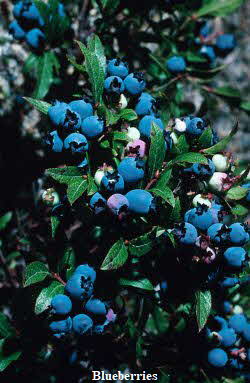BLUEBERRY HISTORYSEE ALSO: Blueberry Terminology & Names
The blueberry of the genus Vaccinium, is a native American species. In fact the blueberry is one of the few fruits native to North America. HISTORY
Native American TraditionFor centuries, blueberries were gathered from the forests and the bogs by Native Americans and consumed fresh and also preserved. The Northeast Native American tribes revered blueberries and much folklore developed around them. The blossom end of each berry, the calyx, forms the shape of a perfect five-pointed star; the elders of the tribe would tell of how the Great Spirit sent "star berries" to relieve the children's hunger during a famine. 
Parts of the blueberry plant were also used as medicine. A tea made from the leaves of the plant was thought to be good for the blood. Blueberry juice was used to treat coughs. The juice also made an excellent dye for baskets and cloth. In food preparation, dried blueberries were added to stews, soups and meats. The dried berries were also crushed into a powder and rubbed into meat for flavor. Blueberries were also used for medicinal purposes along with the leaves and roots. A beef jerky called Sautauthig (pronounced saw'-taw-teeg), was made with dried blueberries and meat and was consumed year round.
Blueberry Thanksgiving:
During the seventeenth century, settlers from England arrived in the New World to begin colonies. Immediately, they set about clearing the land and establishing farms for they could not rely solely on supplies from England. But the land and the climate were far different from what they left behind. Many early attempts at farming failed.
In the winter of 1620, the Pilgrims established a settlement at Plimoth (spelled Plymouth today). Many perished during the first few months, but those that survived went on to build homes and establish farms. Their neighbors, the Wampanoag Indians taught the settlers new skills that helped them survive. They showed them how to plant corn and how to gather and use native plants to supplement their food supply. One important native crop was blueberries!! The colonists learned from Native Americans how to gather blueberries, dry them under the summer's sun and store them for the winter. In time, blueberries became an important food source and were preserved, and later canned. A beverage made with blueberries was an important staple for Civil War Soldiers. In the 1880s a blueberry canning industry began in the Northeast USA.
Blueberry TerminologyVacinnium is the family of all blueberries and includes more than 450 plants. This plant grows wild around the world and there are many names given to different blueberries.
For practical and commercial purposes we concentrate on three different varieties:
Vacinnium corymbosum. (Northern Highbush) Grow in the forests wild in North America and were used to cultivate the modern highbush or cultivated blueberry industry along with the V. Ashei. Vacinnium ashei. (Southern Rabbiteye). You may be suprised to learn that blueberries thrive in the Southern USA. A variety called the Rabbiteye is named this because the calyx on the berry resembles the eye of the rabbit!
Vacinnium angustifolium. (Lowbush or also called "Wild blueberries." These dwarf bushes are very cold hardy, surviving in the wild as far north as Arctic North America. These Blueberries only reach a height of 1 or 2 feet. and include the low sweet Blueberry (V. angustifolium), which is found from the Arctic to Minnesota and the mountains of New York and New Hampshire, and the sour-tasting velvet-leaf Blueberry (V. myrtilloides), which is found wild throughout New England and west.
Other Terms: Many different names have been given to the numerous varieties of Vacinnium that produce edible fruits, such as Blueberry, Bilberry, Cowberry, Cranberry, Crowberry; Farkleberry, Lingonberry, Partridgeberry, Huckleberry (not the true Huckleberry, which is Gaylussacia), Whortleberry, and Sparkleberry to mention a few.
THE IMPROVED BLUEBERRYFor years, blueberries maintained popularity in the USA, with a thriving commercial business in the Northeast USA and Canada. An important step in the development of the highbush blueberry industry came in the turn of the century. Efforts in the early 1900's by Elizabeth White and Dr. Frederick Coville to domesticate the wild highbush blueberry resulted in today's cultivated highbush blueberry industry. They selected desirable plants from the wild forests of the Northeast USA and cultivated them to develop blueberries that could be commercially grown by farmers. Their initial breeding work has resulted in the plump, juicy, sweet and easy to pick cultivated blueberry we enjoy today. Without this cultivation work we would not have fresh blueberries in the markeplace as we do today.
Over the decades, plant breeders and pathologists have worked to identify and enhance the desirable features of various cultivars of highbush blueberries. For decades "cultivated" or "highbush" blueberries have been improved through natural selection and plant breeding programs to produce an optimal blueberry with desirable flavor, texture and color for fresh and processed markets. Cultivated varieties have been enhanced to offer magnificent plump berries with deep, rich color and a delicious fruity flavor. These plant breeding programs have resulted in the development of superior berries both for the consumer and the food processing industry. Our industry owes a great gratitude to the many agriculturalists in the USA and abroad who have pioneered the development of the US Highbush Blueberry industry!
The Modern Highbush Blueberry IndustryToday, the highbush blueberry is grown commercially in more than 38 states and provinces of Canada. Highbush blueberry industries have also developed in South America, Australia, New Zealand and Europe and according to the United Nations Food & Agricultural Organization, more than 42,000 metric tons are harvested each year. Although the USA and Canada are the largest producers and consumers of blueberries, the market around the world is also on the rise with Japan in particular becoming a blueberry loving nation. Courtesy of the US Highbush Blueberry Council
www.blueberry.org | 